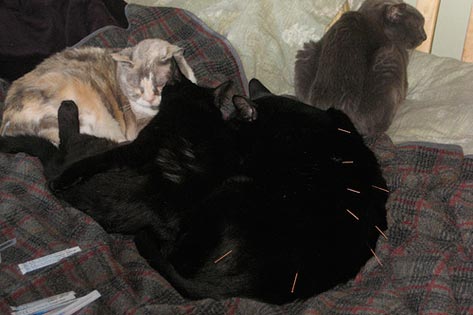External parasites live on a cats skin. They not only cause irritation, but sometimes carry other diseases. As you groom your cat, examine its coat for any evidence of parasites. You want to look carefully for these parasites and see your vet if you find anything unusual. Sometime your cat will scratch to tip you off - othertimes there might be no telltale signs of infection.
Lice are rare in cats and do not spread to humans. Serious infection usually occurs because cats are poorly nourished, neglected and live in unsanitary conditions. Infected cats should be isolated and treated with any of a number of commercial products in the form of dips, sprays or shampoos. Be certain the label states that the product is safe for cats. Always read and follow label directions. Because lice do not live long off the host, a single thorough cleaning of the cats environment should be adequate. Discard vacuum cleaner bags and cleaning rags.
Mange is a general term for parasitic diseases caused by any of several microscopic mites. Signs of mange include excessive shedding, fur loss in patches and bald spots around the eyes, nose or ears. A veterinarian should diagnose and treat a mange infestation as soon as possible.
Cheyetialla mites produce an extensive dry, scaly dust suggestive of dandruff. Other signs include a rash and itching. An affected cat should be isolated from other pets. A dip, powder or shampoo should be used as recommended by a veterinarian. The cats environment should also be treated. In many instances humans are also affected. Treatment by a physician is recommended.
Ear mites are one of the most common ear problems in cats. The mites live on the surface of the skin and pierce the skins surface to feed, causing considerable inflammation and discomfort. The skin-piercing is accompanied by an accumulation of dark brown granular material composed of dried blood and wax within the ear canal.
Scratching the ears, head shaking and brown debris inside the ear are signs of ear mites. If left untreated, ear mites cause serious problems such as secondary bacterial infections, torn and bleeding ear tissues resulting from excessive scratching, and, in extreme cases, loss of hearing.
Cats who spend considerable time outdoors have a greater incidence of mites than those housed inside. Young kittens can get mites from their mother. Although mites are not transmitted to people, they can be transmitted to other household pets. For all mite infections, your veterinarian can provide diagnosis and effective treatment.
Taking your cat to the vet on a regular basis can help prevent or treat these pesky cat parasites.

 The Ultimate Guide to Eliminating Cat Pee Smell
By Michelle Shapiro
When your ca
The Ultimate Guide to Eliminating Cat Pee Smell
By Michelle Shapiro
When your ca
 The Right Foods for Kittens
Kittens need certain nutrients to grow str
The Right Foods for Kittens
Kittens need certain nutrients to grow str
 Making Ends Meet While Eating Healthy - You and Your Cat!
When considering the cost of feeding your cat alon
Making Ends Meet While Eating Healthy - You and Your Cat!
When considering the cost of feeding your cat alon
 Kitten Checklist: Getting off to a Great Start
Buying the Right Kitten Supplies
By Jessica Vogel
Kitten Checklist: Getting off to a Great Start
Buying the Right Kitten Supplies
By Jessica Vogel
 Acupuncture for Cats
The Holistic Science Behind Acupuncture for Pe
Acupuncture for Cats
The Holistic Science Behind Acupuncture for Pe